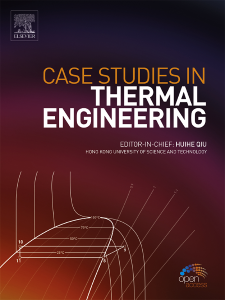基于磁偶极的粘塑性纳米材料的热性能研究,涉及不同的流变学方面
IF 6.4
2区 工程技术
Q1 THERMODYNAMICS
引用次数: 0
摘要
与传统液体相比,磁性纳米液体具有独特的磁性,可以利用磁场对其进行调节。因此,可以通过外部强加的磁场来刺激或调节热传递。与正统或非磁性纳米液体相比,磁性纳米液体非常有用。这些领域包括能源转换、电子学、水力学、热能工程和生物工程。本研究阐述了磁偶极对对流加热流变纳米材料的影响。数学建模基于热辐射粘塑性(Casson)模型。多孔介质特征通过达尔西安-福赫海默(Darcian Forchheimer,DF)关系进行研究。双组分 Buongiorno 纳米材料模型可捕捉布朗扩散和热泳扩散。能量和溶质传输表达式捕捉了热源和化学反应效应。通过使用相似变量,获得了用于拉伸流动的尺寸化纳米材料流动模型。通过 Bvp4c 方案计算数值解。物理结果以图形和算术方式阐明了无量纲量(即努塞尔特数、温度、表皮摩擦、速度、舍伍德数和浓度流)。报告了一个基准,以验证所获得的数值解决方案。结果进一步表明,纳米材料的温度会随着热比奥特数、居里温度系数、辐射系数、热泳参数、热源、铁流体力学相互作用系数和布朗扩散参数的升高而升高,同时会随着普朗特数和耗散系数的降低而降低。本文章由计算机程序翻译,如有差异,请以英文原文为准。
A thermal performance study on magnetic dipole based viscoplastic nanomaterial deploying distinct rheological aspects
Magnetic nanoliquids stand inimitable when compared with conventional liquids as their distinctive magnetic attributes can be regulated utilizing magnetic fields. For this reason, heat transference can be stimulated or regulated subjected to externally imposed magnetic fields. Magnetic nanoliquids are useful in comparison to orthodox or non-magnetic nanoliquids. These encompasses, energy conversion, electronics, hydraulics, thermal engineering and bioengineering. This study elaborates the magnetic dipole impact on convectively heated rheological nanomaterial confined by stretchy surface. Mathematical modeling is based on thermally radiative viscoplastic (Casson) model. Porous medium features are scrutinized through Darcian Forchheimer (DF) relation. Two-component Buongiorno nanomaterial model which captures Brownian diffusive together with thermophoretic diffusion is under consideration. Energy and solutal transportation expressions capture thermal source and chemical reaction effects. The dimensionalized nanomaterial flow model for stretching flow is obtained by deploying similarity variables. Numerical solutions are computed through Bvp4c scheme. The physical outcomes are elucidated graphically and arithmetically on dimensionless quantities (i.e., Nusselt number, temperature, skin-friction, velocity, Sherwood number and concentration streams). A benchmark is reported to authenticate the acquired numeric solutions. It is further visualized that nanomaterial temperature escalates subject to higher estimations of thermal Biot number, Curie temperature factor, radiation factor, thermophoresis parameter, heat source, ferrohydrodynamic interaction factor and Brownian diffusive parameter while it diminishes with Prandtl number and dissipation factor.
求助全文
通过发布文献求助,成功后即可免费获取论文全文。
去求助
来源期刊

Case Studies in Thermal Engineering
Chemical Engineering-Fluid Flow and Transfer Processes
CiteScore
8.60
自引率
11.80%
发文量
812
审稿时长
76 days
期刊介绍:
Case Studies in Thermal Engineering provides a forum for the rapid publication of short, structured Case Studies in Thermal Engineering and related Short Communications. It provides an essential compendium of case studies for researchers and practitioners in the field of thermal engineering and others who are interested in aspects of thermal engineering cases that could affect other engineering processes. The journal not only publishes new and novel case studies, but also provides a forum for the publication of high quality descriptions of classic thermal engineering problems. The scope of the journal includes case studies of thermal engineering problems in components, devices and systems using existing experimental and numerical techniques in the areas of mechanical, aerospace, chemical, medical, thermal management for electronics, heat exchangers, regeneration, solar thermal energy, thermal storage, building energy conservation, and power generation. Case studies of thermal problems in other areas will also be considered.
 求助内容:
求助内容: 应助结果提醒方式:
应助结果提醒方式:


